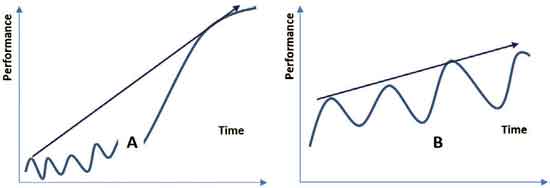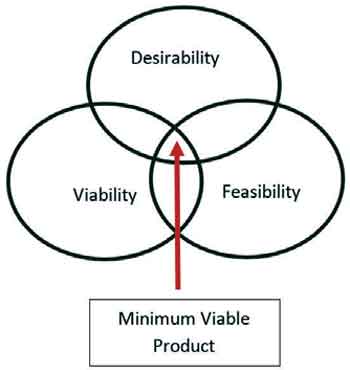Tuesday Dec 02, 2025
Tuesday Dec 02, 2025
Friday, 20 October 2023 00:01 - - {{hitsCtrl.values.hits}}

 Some leading brands, for example, Facebook, Uber, Airbnb, Amazon, Spotify, Dropbox, and Twitter, all initially came out with some basic features to provide the core functionality of the products and offered at the beginning to test the hypothesis. This approach helped all these brands to validate the business idea, learn from the feedback to discover and develop the strategic customer, design the business model, and establish a system that helps in scaling up to achieve exponential growth
Some leading brands, for example, Facebook, Uber, Airbnb, Amazon, Spotify, Dropbox, and Twitter, all initially came out with some basic features to provide the core functionality of the products and offered at the beginning to test the hypothesis. This approach helped all these brands to validate the business idea, learn from the feedback to discover and develop the strategic customer, design the business model, and establish a system that helps in scaling up to achieve exponential growth
 Many big brands have spent considerable time to learn at the startup stage to lay the foundation for the right growth trajectories and build the agility needed to withstand any shock. For example, Apple and Starbucks spent more than 25 years constructing the right system to take a steep scale-up journey. The steep learning, at the startup stage, gained from customer feedback and consistent reiteration and development helps the businesses to establish super systems that help to scale up exponentially
Many big brands have spent considerable time to learn at the startup stage to lay the foundation for the right growth trajectories and build the agility needed to withstand any shock. For example, Apple and Starbucks spent more than 25 years constructing the right system to take a steep scale-up journey. The steep learning, at the startup stage, gained from customer feedback and consistent reiteration and development helps the businesses to establish super systems that help to scale up exponentially
 Considering the above quote by Jobs, startups need to seriously accept the point that having a great idea alone would not guarantee success. This insists the fact that every startup with its idea, however good it is, has to discover the right customer, and then devise the repetitive and scalable business model to create the company through proper systematisation. The best proposal is to take the business idea out to the customer for feedback, as knowledge lies outside the building, mostly, where the customer is.
Considering the above quote by Jobs, startups need to seriously accept the point that having a great idea alone would not guarantee success. This insists the fact that every startup with its idea, however good it is, has to discover the right customer, and then devise the repetitive and scalable business model to create the company through proper systematisation. The best proposal is to take the business idea out to the customer for feedback, as knowledge lies outside the building, mostly, where the customer is.
Typically, every business needs to gain fast and high scalability to grow big since the startup stage. Scalability is not something plugged into the business instantly or available off the shelves. Rather, scalability should be built in since the startup, on the business’s DNA. Every business has to first discover its right customers and validate them to create customers and build the company with the right scalable systems.
In today's resource-constrained environment, every startup is under pressure to get through the initial stages of the business model discovery and company creation, with less time and resources. In the first stage of a startup, once the business idea is conceptualised, the owner has to formulate some untested hypothesis. The hypothesis is then tested to ascertain how far it fits the market. This helps to discover the right customer and the right business model. Hence, businesses need to take a methodical approach to bring the idea to commercial form with less time and resources in a constrained situation. The best practice adopted by many successful startups to establish business models capable of achieving exponential growth is by first entering the market with a Minimum Viable Product (MVP) that consists of basic functionalities to attract early adopters, at the startup stage. 
“A Minimum Viable Product is that version of a new product that allows a team to collect the maximum amount of validated learning about customers with the least effort,” Eris Ries
A startup has to cross four hurdles to gain capabilities to scale up. First, the customer has to be discovered, then the customer should be validated with the business idea, third, once the first two stages are completed customer development would take place, and when the three stages are done the company is created. The MVP has to facilitate the first two stages. Hence, MVP predominantly does not only cover the product idea but the whole business model. In other words, testing the hypothesis with MVP not only helps a business to validate the product idea but to validate the whole business idea that covers the business model. A key objective of this initial learning stage is to understand what kind of company is to be built with the right systems. Hence, MVP saves time, effort, and money by letting one to test the market before committing unnecessary investments.
Leading brands started with basic features
Some leading brands, for example, Facebook, Uber, Airbnb, Amazon, Spotify, Dropbox, and Twitter, all initially came out with some basic features to provide the core functionality of the products and offered at the beginning to test the hypothesis. This approach helped all these brands to validate the business idea, learn from the feedback to discover and develop the strategic customer, design the business model, and establish a system that helps in scaling up to achieve exponential growth. All these startups initially came out with a product with basic features consisting of only core functionalities to meet the exact need of the customer to attract early adopters. Uber first came out with an MVP focused on a single feature; booking a ride where users could specify their location in the application, and then Uber would find a cab within the rider's proximity and dispatch it to that location. Fundamentally, Uber realized that the trigger point of the whole business is booking a ride. That MVP helped Uber to engage with customers in fruitful conversation and learn from feedback to scale exponentially to become a global IT company from San Francisco. The continuous iteration of just an app based on MVP has led Uber to become a multibillion-value company with lean and minimum asset base.
The first step in developing the MVP is to understand the problem the product tries to solve. Then based on the problem a business needs to identify the gain and pain points from the point of view of the customer to formulate the hypothesis based on the idea. Once the concept is defined, the business needs to decide on the features to be included in the first version with correct design elements. After these activities are completed the MVP is ready for testing. The learning from every test to be analysed and incorporated into the MVP in terms of version, changes.
Generally, a successful idea emanates by the intersection of three constraints as shown in the following model in figure 1. Ideally, the tension caused between these three constraints at the intersection is the space where creative ideas outbreak to formulate the MVP.
The model in Figure 1 provides clear guidelines for developing MVPs based on three constraining criteria. Desirability refers to designing features based on threshold-level features to attract the customer. Feasibility refers to the know-how and technology required to make such a basic version of the product. Viability refers to the economics of making such an MVP at a positive value.
The business owner must appreciate the fact that the untested hypothesis is to be tested to validate the idea. The testing is to be carried out outside the building as the customer and also the information lie outside the building and the planning room. When testing the hypothesis the communication between the customer and the business must be mediated by an understandable and facilitative language. Minimum viable products (MVP) as a prototype of the products help businesses to engage the customer in evaluating the idea and the hypothesis. MVPs help to collect the maximum amount of learning with less effort in a well understandable and explainable manner. The main objective of releasing an MVP is to evaluate the product market fit as early as possible.
Customer’s feedback necessary
As we are aware, businesses need to obtain sufficient feedback from target customers about the efficacy of the hypothesis before committing much investment. Learning at early stages by failing helps to improve the endurance of the business and avoid the big costs of unlearning whenever necessary at any point in the future. Figure 2 illustrates the power of learning by failure at the initial stages.
As mentioned above some of the leading brands like Uber, Facebook, and Airbnb all invested much time and effort on learning with MVPs to actively engage the customers in the journey towards achieving exponential scaling capabilities.
Figure 2
Many big brands have spent considerable time to learn at the startup stage to lay the foundation for the right growth trajectories and build the agility needed to withstand any shock. For example, Apple and Starbucks spent more than 25 years constructing the right system to take a steep scale-up journey. The steep learning, at the startup stage, gained from customer feedback and consistent reiteration and development helps the businesses to establish super systems that help to scale up exponentially. Chart A shows the behaviour of the performance of the companies that take a lean startup approach, which not only minimises the cash burn at the beginning but helps the businesses to enjoy exponential growth at the scaling-up stage.
As depicted in Chart A companies that failed frequently and learned fast, at the startup stage, could learn from the mistakes fast and design the ideal DNA of the business system for scale-up. The initial struggle has helped businesses to identify key growth trajectories, build growth muscles, and build the system with the right processes, governance, and structure to scale up.
While testing with MVP, a startup has to validate the effectiveness of MVP towards discovering and validating customers. The efficacy of the MVP is judged by both quantitative and qualitative indicators such as the number of visitors to the site, number of users, number of iterations, number of conversations and the quality of feedback, number of repeat customers, speed of adoption, customer acquisition cost, number of early adopters, customer churn, referrals and discounts.
(The writer is the CFO and COO at Emerald International Ltd.)